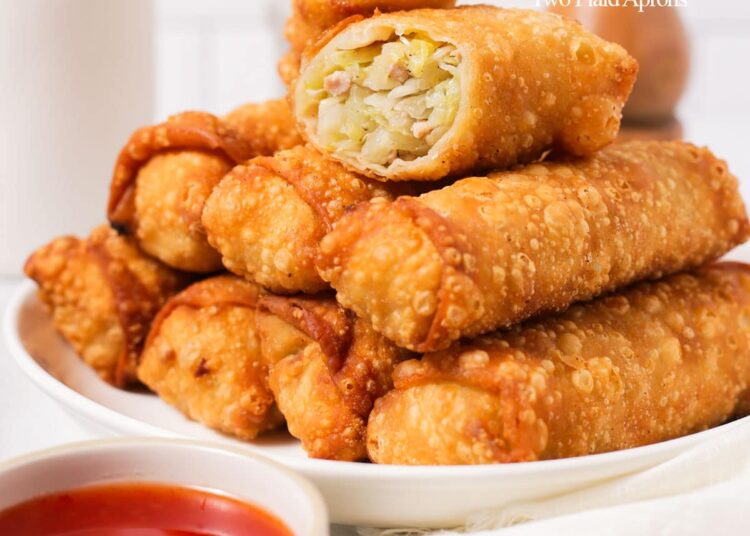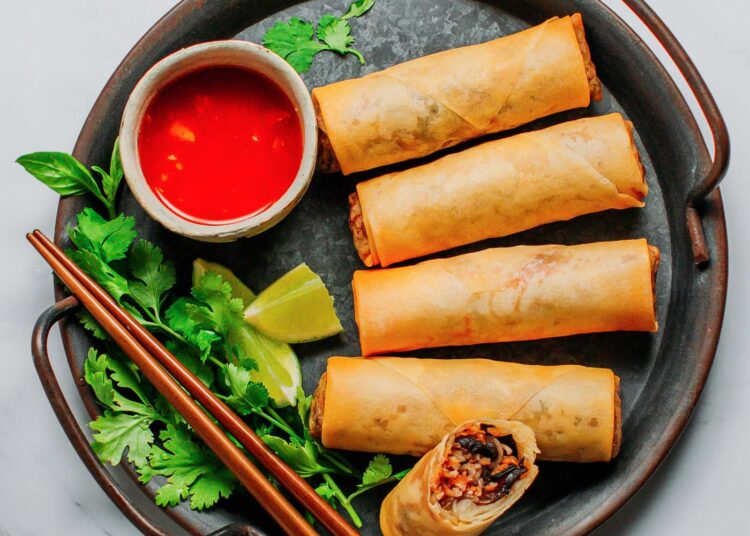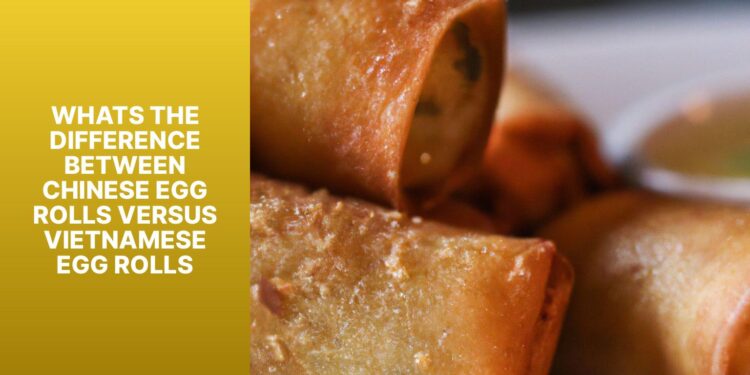Culinary delights, such as Chinese egg rolls and Vietnamese egg rolls cuisines, are popular across the world. Egg rolls are a beloved dish in both cultures, yet they have distinct differences that make them unique.
Chinese egg rolls are a staple in many Chinese restaurants. They are savory and crispy with a filling of cabbage, carrots, bean sprouts, and sometimes meat. Soy sauce, ginger, and garlic give it a rich flavor. They are known for their larger size compared to their Vietnamese counterpart.
Vietnamese egg rolls, also known as “”cha gio,”” are smaller but are packed with flavor. The filling is ground pork mixed with mushrooms, onions, carrots, and glass noodles. What sets them apart is the inclusion of mung bean noodles, adding a unique texture.
I experienced both versions on a trip to San Francisco’s Chinatown and Hanoi. The Chinese egg rolls had layers of cooked vegetables in a crispy golden pastry. The flavors were balanced and delicious. The Vietnamese egg rolls were smaller but equally satisfying. The combination of pork, mung bean noodles, and herbs and fish sauce created a delightful symphony for my taste buds.
Brief history and origins of Chinese Egg Rolls
The Chinese egg roll is centuries-old. It originated in east China during the Tang Dynasty. Popular among the imperial court, its fame spread to other regions.
This dish is made by filling a wheat flour wrapper with cabbage, carrots, bean sprouts and meats. These are chopped and stir-fried before wrapping. Then deep-frying until golden brown and crispy.
In contrast to the Vietnamese version, the Chinese egg roll uses a wheat flour wrapper instead of rice paper. This gives it a thicker and chewier texture.
Legend says that during the Yuan Dynasty, Mongolians rolled spring onions with meat and veggies. This evolved into the Chinese egg roll.
Both versions offer a delightful combination of flavors and textures. Making egg rolls a beloved staple in Asian cuisine.
Description and ingredients of Chinese Egg Rolls

Chinese Egg Rolls are a beloved dish from Chinese cuisine. They are made with a thin dough, filled with various ingredients and deep-fried until crispy. Common fillings include meat (e.g. pork or shrimp), veggies (like cabbage, carrots, and bean sprouts) and seasonings (soy sauce, ginger, garlic). Dipping sauces like sweet and sour or plum sauce are served alongside them.
Table summarizing description & ingredients of Chinese Egg Rolls:
| Description | Ingredients |
|---|---|
| Thin dough | Meat (pork or shrimp) |
| Crispy texture | Vegetables (cabbage, carrots, bean sprouts) |
| Filled with various ingredients | Seasonings (soy sauce, ginger, garlic) |
| Served with dipping sauce |
Chinese Egg Rolls have unique details. Spring roll wrappers are often used to make them. These wrappers provide a light & crispy texture when fried. Plus, fillings can vary depending on region & personal preference.
A bit of history reveals that Chinese Egg Rolls were brought over from Vietnam. Over the years, chefs adapted the recipe to local tastes, making it their own. Nowadays, Chinese Egg Rolls are a staple in Chinese cuisine & loved worldwide.
Popular variations of Chinese Egg Rolls
Time to dive into the world of Chinese Egg Rolls! They come in pork, shrimp, or veggie variations. The secret to their crunchy texture and golden exterior lies in the wheat-based wrappers they use.
Chinese Egg Rolls have a history that dates back centuries. To the Tang Dynasty (618-907 AD) to be exact. Initially, they were made for special occasions, but now they’re an everyday treat for people around the world.
Pork Egg Rolls are filled with pork and cabbage. Shrimp Egg Rolls contain plump shrimp and vegetables. And Vegetable Egg Rolls are a delight for vegetarians, with carrots, mushrooms, and bean sprouts.
No matter what you’re in the mood for, Chinese Egg Rolls offer a culinary adventure. A journey through time-honored traditions and flavorful treats.
Cooking techniques for Chinese Egg Rolls
Delicious Chinese Egg Rolls are an iconic dish with a distinctive cooking method. These scrumptious and flavourful treats are made with a precise set of steps to ensure their yumminess. To achieve a perfect Chinese Egg Roll, one must follow these cooking techniques exactly.
- Preparations: Gather all the necessary ingredients. This could include shredded cabbage, carrots, bean sprouts, minced meat or shrimp, soy sauce, and spices. Have all the ingredients ready before you start.
- Filling: Start by stir-frying the cabbage, carrots, and bean sprouts in a hot wok or pan. Add minced meat or shrimp to intensify the flavor. Season with soy sauce and other spices to your liking.
- Wrapping: Grab a spring roll wrapper and place it on a clean surface diagonally, forming a diamond shape. Put some of the filling onto one corner of the wrapper and fold it over once. Fold the sides towards the center like an envelope, then roll up until you reach the opposite corner.
- Frying: Heat oil in a deep skillet or wok over medium heat. Place each egg roll into the hot oil, ensuring they are fully submerged but not overcrowded. Fry until golden brown and crispy on all sides, turning occasionally.
- Serving: Remove the egg rolls from the oil and drain on paper towels. Serve hot with your favorite dipping sauces such as sweet chili sauce or soy sauce with garlic and ginger.
Chinese Egg Rolls have been a part of Chinese cuisine for centuries, as far back as ancient times in China! They were traditionally served during special occasions and festivals as symbols of luck and prosperity.
Over time, Chinese Egg Rolls have adapted. Different regions in China have added their own ingredients and flavors, creating unique regional variations of the beloved dish.
Flavors and taste profile of Chinese Egg Rolls
Chinese Egg Rolls are a true taste sensation! Crispy, savory, and subtly sweet – these treats offer a unique mix of textures and flavors. Let’s take a closer look at the flavors and taste profile in a table:
| Flavors and Taste Profile | Description |
|---|---|
| Crispy Exterior | A thin, fried outer shell for maximum crispiness. |
| Savory Filling | Veggies, like cabbage, carrots, and mushrooms, plus seasoned ground meat or shrimp. Packed with umami. |
| Subtle Sweetness | Variations may include a touch of sweetness with oyster or hoisin sauce. |
| Complex Seasonings | Traditional ingredients like soy sauce, ginger, garlic, and five-spice powder. |
The cooking method is also important. Deep frying ensures the exterior is crispy and the filling stays moist. Chinese culinary traditions created egg rolls with a perfect balance of flavors.
It’s incredible that Chinese Egg Rolls trace their origins back to the Tang Dynasty (618-907 AD). Delicious for over 1,000 years!
Brief history and origins of Vietnamese Egg Rolls
Vietnamese Egg Rolls have a unique history with diverse origins. They are said to be influenced by Chinese cuisine, but they have evolved into something special.
Making them is a meticulous process that shows the country’s flavors and techniques. Filling is usually pork or shrimp, combined with veggies like carrots, mushrooms, and taro. Herbs and spices give it a distinct taste, unlike its Chinese counterpart.
Wrapped in rice paper or thin wheat flour, they are then deep-fried. This creates a golden-brown color and crunchy texture.
Vietnamese Egg Rolls are lighter and fresher than Chinese ones. Fresh ingredients, such as locally grown veggies and high-quality meats, give them an authentic flavor from Vietnamese cooking traditions.
One story tells how they became symbolic during the Vietnam War. Soldiers wrapped them in banana leaves to keep them fresh while on the battlefield. This nourishment and comfort made them a key part of Vietnamese culture.
Description and ingredients of Vietnamese Egg Rolls

Vietnamese Egg Rolls are a delicious treat that’s full of flavor. From Vietnam, they have special features that make them different from Chinese ones. To understand them more, let’s look at their description and ingredients:
| Column 1 | Column 2 |
|---|---|
| Description | Crispy and flavorful |
| Main Ingredient | Rice paper wrappers |
| Filling | Ground pork, shrimp, vegetables |
| Aromatic touch | Herbs like cilantro and mint |
Vietnamese Egg Rolls are a mix of tastes and textures. Their delicate rice paper wrappers contain a mixture of pork, shrimp, and veggies. Herbs like cilantro and mint add an extra flavor. The rice paper wrappers are also unique – unlike Chinese Egg Rolls, which use wheat-based wrappers.
Here’s a story: one time in Hanoi, I found a small family-run shop with amazing egg rolls. Each one was crispy and full of savory goodness. It made me think of the stories behind these recipes, passed down over generations.
We’ve learned about the unique Vietnamese Egg Rolls. As you enjoy each bite, remember the rich history behind this dish!
Popular variations of Vietnamese Egg Rolls
Vietnamese cuisine has a wide range of delicious egg rolls. They’re filled with flavor and texture, making them a hit among food fans. Let’s take a look at some famous Vietnamese egg roll variations!
| Gá»i cuốn | Wrapped in rice paper, this one has vermicelli noodles, lettuce, herbs, and shrimp or grilled meat. |
| Chả giò tôm | These crunchy rolls are filled with ground shrimp, mushrooms, carrots, onions, and bean sprouts. |
| Nem nÆ°á»›ng | From Hue city, these pork rolls come with herbs, cucumber slices, and a special dipping sauce. |
| Bò bÃa | A veggie version with julienned vegetables, tofu, and Chinese sausage – all wrapped in rice paper. |
Vietnamese egg rolls come in fried and fresh forms. The fried ones are crunchy and full of flavor. Fresh ones are brighter and lighter.
The history of Vietnamese egg rolls goes back to the Ming Dynasty. Chinese migrants brought their cooking techniques to Vietnam. Over time, Vietnamese added their own ingredients and flavors to the rolls.
Vietnamese egg rolls are a sign of Vietnam’s rich food culture. With their variations and roots, they still thrill food lovers all over the world. From Gá»i cuốn to Chả giò tôm, each variation offers a unique experience that must not be missed.
Cooking techniques for Vietnamese Egg Rolls
Get ready to make the perfect Vietnamese egg roll! Here are the steps:
- Get prepped: Gather ground pork, shrimp, cabbage, carrots, mushrooms, and bean sprouts. Chop the veggies and set aside.
- Assemble: Place a spring roll wrapper on a clean surface. Add a spoonful of filling on the bottom half, leaving space on the sides. Fold sides and roll up tight.
- Fry: Heat veggie oil in a pot or pan over medium-high heat. Put each roll into the hot oil and fry until golden and crispy. Keep the temp steady.
- Serve: Drain rolls on paper towels. Serve with sweet chili sauce or fish sauce for extra flavor.
Try different fillings or bake your egg rolls for a healthier option. Practice makes perfect! This delicious dish is ready to be made at home.
Flavors and taste profile of Vietnamese Egg Rolls
Vietnamese Egg Rolls are known for their yummy flavors and special taste. These amazing rolls give an amazing flavor that will make your tongue beg for more. Let’s explore the great features of Vietnamese Egg Rolls.
To understand the flavors and taste of these egg rolls, we must look at the main elements. The wrapper is made out of delicate rice paper and inside is a mix of pork, shrimp, vermicelli noodles, and veggies. This blend creates an explosion of salty, umami flavors.
Here is a table to show the elements and flavors:
| Component | Flavor |
|---|---|
| Rice paper | Delicate |
| Ground pork | Savory |
| Shrimp | Seafood |
| Vermicelli | Textured |
| Vegetables | Fresh |
Vietnamese Egg Rolls have other unique traits. Unlike Chinese Egg Rolls, these are usually served fresh or lightly fried, making them not very oily. Plus, they often contain herbs like mint or cilantro for added freshness.
Let me tell you a story about these egg rolls. Last year, I went to Vietnam and tried them. They were hot and crispy with a side of sweet and sour sauce. The flavor was amazing – like I found a hidden treasure in each roll! This experience showed me how great the flavors of Vietnamese food are.
Key differences between Chinese Egg Rolls and Vietnamese Egg Rolls
To understand the key differences between Chinese Egg Rolls and Vietnamese Egg Rolls, dive into the wrapper, filling, seasoning and spices, and serving and accompaniments. Uncover how each element distinguishes these two delectable dishes, and discover the unique qualities they bring to the table.
Wrapper
The wrapper for Chinese and Vietnamese egg rolls is different in many ways. The following chart shows the key distinctions in an easy to understand way:
| Wrapper Type | Chinese Egg Rolls | Vietnamese Egg Rolls |
|---|---|---|
| Texture | Light and crispy | Thin and slightly chewy |
| Ingredients | Wheat-based dough | Rice paper sheets |
| Cooking Technique | Deep-fried till golden brown | Pan-fried or deep-fried until crispy |
| Appearance | Thick and crunchy | Thin, delicate and see-through |
Chinese egg rolls are known for their light and crispy texture. This comes from wheat-based dough. Vietnamese egg rolls have a thin and chewy wrapper made from rice paper. This difference affects the eating experience.
Chinese egg rolls are deep-fried to a golden brown. This gives them a crunchy outside but keeps the moisture inside. Vietnamese egg rolls can be pan-fried or deep-fried to get a crispy texture.
Chinese egg rolls have a thick and crunchy wrapper that covers the filling. Vietnamese egg rolls have a thin and delicate wrapper due to their see-through rice paper.
Pro Tip: To add more flavor, brush soy sauce or dipping sauce lightly on the wrapped egg rolls before serving. This will make them taste better without overpowering the unique flavors.
Filling
Chinese and Vietnamese egg rolls differ greatly in their fillings: a key factor in determining taste and texture. Let’s examine the differences between them! A table showing variations in fillings is presented below.
| Chinese Egg Rolls | Vietnamese Egg Rolls |
|---|---|
| Ground pork | Bean sprouts |
| Shredded cabbage | Carrots |
| Shrimp | Vermicelli noodles |
| Scallions | |
| Water chestnuts |
Chinese egg rolls typically contain ground pork, shredded cabbage, shrimp, scallions, and water chestnuts. This creates a flavorful filling. On the other hand, Vietnamese egg rolls have bean sprouts, carrots, and vermicelli noodles for a light and refreshing taste.
The texture of Chinese egg rolls is slightly crispy due to pan-frying or stir-frying before rolling. Whereas Vietnamese egg rolls are deep-fried without prior cooking of the filling ingredients, giving them a crunchy exterior and juicy interior.
Pro Tip: Spice up the flavors of both egg rolls with different dipping sauces. Try soy sauce or sweet chili sauce. These condiments complement the fillings and make your culinary experience even better!
Seasoning and spices
Chinese and Vietnamese egg rolls differ in terms of spices and seasoning. Chinese egg rolls are bold and savory, with a blend of soy sauce, ginger, garlic, and Chinese five spice powder. Vietnamese egg rolls, on the other hand, are lighter and fresher with cilantro, mint, and Thai basil. Check out the comparison table below to see the difference:
| Ingredient | Chinese Egg Rolls | Vietnamese Egg Rolls |
|---|---|---|
| Soy sauce | Yes | No |
| Ginger | Yes | No |
| Garlic | Yes | No |
| Chinese five spice | Yes | No |
| Cilantro | No | Yes |
| Mint | No | Yes |
| Thai basil | No | Yes |
It’s important to remember that these differences in seasoning reflect cultural traditions. Chinese cuisine is bolder in flavor, while Vietnamese cuisine is lighter with aromatic herbs. Knowing this helps you appreciate the unique taste of each type of egg roll.
These egg rolls have a long history. They originated in ancient China, and variations developed in different regions. Vietnam then adopted this tradition during its cultural exchange with China. Vietnamese egg rolls have evolved to include their own flavors and ingredients, reflecting the country’s culture.
Serving and accompaniments
Chinese and Vietnamese egg rolls have distinct serving styles and condiments. Thick, crispy wrappers are used for Chinese egg rolls, with savory meat and vegetable fillings. Vietnamese egg rolls have delicate, translucent rice paper wrappers with fresh vegetables, herbs, and seafood fillings.
Sweet and sour sauce or soy sauce is served with Chinese egg rolls, and Nuoc Cham (fish sauce-based dipping sauce) accompanies the Vietnamese egg rolls. Chinese egg rolls have a richer flavor due to their meat-filled filling, while Vietnamese egg rolls prioritize freshness with vegetables, herbs, and seafood.
Hot mustard is often served with Chinese egg rolls, and Vietnamese egg rolls are typically accompanied by lettuce and mint leaves.
For a tasty experience, pair Chinese and Vietnamese egg rolls with their traditional dipping sauces. The contrasting tastes will add depth to the meal.
Cultural significance and regional variations
Comparing Chinese and Vietnamese egg rolls can reveal their cultural significance and regional variations. The table below explains the differences:
| Chinese Egg Rolls | Vietnamese Egg Rolls |
|---|---|
|
|
For Chinese egg rolls, the main ingredients are spring roll wrappers, cabbage, and carrots. Whereas for Vietnamese egg rolls, the ingredients are rice paper wrappers, ground pork, shrimp, bean sprouts, and mung bean noodles.
The cooking method is also different. Chinese egg rolls are usually deep-fried for a crispy texture. Vietnamese egg rolls, on the other hand, are usually served fresh or fried briefly for a crunchy exterior but still soft interior.
Don’t miss out on experiencing these unique culinary delights! Explore their flavors and textures for a wonderful gastronomic adventure!
Posts You Might Like
Egg Rolls vs Summer Rolls – What’s the Difference?
Spring Rolls Vs Summer Rolls – What’s The Difference
Conclusion
Egg rolls are a beloved dish in Chinese and Vietnamese cuisines. But, they have some key differences. This article will help you understand the contrasts between Chinese and Vietnamese egg rolls.
Chinese egg rolls usually have diced vegetables like cabbage, carrots, and bean sprouts stir-fried then wrapped in a wheat flour wrapper. Then, they are deep-fried until crunchy and savory. Soy sauce, oyster sauce, and other seasonings add extra flavor.
Vietnamese egg rolls have shredded carrots, mung bean noodles, and pork or shrimp for a richer taste. They are wrapped in a rice flour wrapper for a lighter and chewier texture. They are fried golden brown, and served with herbs like cilantro and mint for aroma.
Legend says Chinese immigrants brought egg rolls to Vietnam during colonial times. However, the Vietnamese adapted it by using local ingredients and techniques. For example, banh trang cuon thit nuong – grilled pork summer rolls – are a combination of Chinese spring rolls and Vietnamese egg rolls. They have grilled marinated pork and herbs and veggies in moist rice paper – they are delicious!
Frequently Asked Questions
What is the main difference between Chinese Egg Rolls and Vietnamese Egg Rolls?
The main difference lies in the wrapper used. Chinese Egg Rolls are typically made with a wheat-based wrapper, while Vietnamese Egg Rolls use a rice-based wrapper.
How does the filling differ in Chinese and Vietnamese Egg Rolls?
Chinese Egg Rolls often contain a combination of vegetables, meat (usually pork), and sometimes shrimp. On the other hand, Vietnamese Egg Rolls commonly consist of a mix of ground pork, carrots, glass noodles, and mushrooms.
Are the cooking methods different for Chinese and Vietnamese Egg Rolls?
Yes, the cooking methods differ. Chinese Egg Rolls are usually deep-fried until golden brown, while Vietnamese Egg Rolls are typically deep-fried until they become crispy and light.
Can Chinese Egg Rolls and Vietnamese Egg Rolls be served with different dipping sauces?
Absolutely! Chinese Egg Rolls are commonly served with soy sauce or sweet and sour sauce, while Vietnamese Egg Rolls are often accompanied by nuoc cham, a tangy fish sauce-based dip.
Are Chinese Egg Rolls and Vietnamese Egg Rolls equally popular in their respective cuisines?
Yes, both types of egg rolls are highly popular in their respective cuisines. Chinese Egg Rolls are a staple of Chinese-American cuisine, while Vietnamese Egg Rolls play a significant role in Vietnamese cuisine.
Are there any regional variations within China or Vietnam for egg rolls?
Yes, both China and Vietnam have regional variations for egg rolls. Chinese Egg Rolls may differ in ingredients and sizes across different provinces. Similarly, Vietnamese Egg Rolls may vary in ingredients and dipping sauces across different regions in Vietnam.









